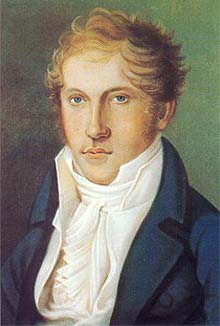Related Research Articles

A string quintet is a musical composition for five string players. As an extension to the string quartet, a string quintet includes a fifth string instrument, usually a second viola or a second cello, or occasionally a double bass.

Louis Spohr, baptized Ludewig Spohr, later often in the modern German form of the name Ludwig was a German composer, violinist and conductor.
This article is about music-related events in 1840.
This is a list of music-related events in 1805.

In classical music, a string sextet is a composition written for six string instruments, or a group of six musicians who perform such a composition. Most string sextets have been written for an ensemble consisting of two violins, two violas, and two cellos.

Bernhard Molique was a German violinist and composer.
The Concerto for String Quartet and Orchestra in B-flat is a work by the Austrian composer Arnold Schoenberg, freely composed after the Concerto Grosso Op. 6, No. 7 by George Frideric Handel.

August Joseph Norbert Burgmüller was a German composer, renowned for his contributions during the nascent stages of the Romantic Era. His oeuvre, albeit cut tragically short due to his untimely drowning at the age of 26, continues to resonate in the annals of classical music.

The String Octet in E-flat major, Op. 20, MWV R 20, was written by the 16-year-old Felix Mendelssohn during the fall of 1825 and completed on October 15. Written for four violins, two violas, and two cellos, this work created a new chamber music genre. Conrad Wilson summarizes much of its reception ever since: "Its youthful verve, brilliance and perfection make it one of the miracles of nineteenth-century music." This was one of the first works of Mendelssohn to be very well received.

A string octet is a piece of music written for eight string instruments, or sometimes the group of eight players. It usually consists of four violins, two violas and two cellos, or four violins, two violas, a cello and a double bass.
String Quartet No. 16 may refer to:
Louis Spohr's String Quartet No. 30 in A major, Op. 93, was completed in September of 1835, it is one of eight such works Spohr wrote between 1806 and 1835. He would not write another string quartet for ten years.
Louis Spohr's String Quartet No. 3 in D minor, Op. 11, was completed in 1806, then published in 1808. It is the first of eight quatuors brillants written by Spohr. Inspired by similar works written by Viotti and Rode, the composition is a mini-concerto, written to provide the composer with the means of demonstrating his skills with a violin in a more intimate setting than a concert hall.
Potpourri No. 4 in B major, Op. 24, by Louis Spohr, was completed in 1808. The work was one of several compositions that Spohr, a noted violinist, wrote to provide a virtuoso encore when performing more serious chamber works such as Beethoven's Opus 18 string quartets. Written for a virtuoso first violin, with accompanying string trio, like many similar works of this period, was based on themes from popular operas, in this case Mozart's Die Entführung aus dem Serail and Don Giovanni.
Louis Spohr's String Quartet No. 19 in A major, Op. 68, was composed by Spohr in 1823. Like a concerto, the work is designed to display a soloist's skills, but in a more intimate setting than the concert hall.
Louis Spohr's String Quartet No. 6 in G minor, Op. 27, was completed in 1812. Dedicated to Count Razumovsky, the dedicatee of Beethoven's Opus 59. string quartets, the composition, like the earlier String Quartet No. 3, is a concertante work with the musical emphasis being placed on the first violinist, while the other players act as accompaniment. Keith Warsop notes that the Adagio second movement seems to have been adapted from sketches to an unfinished violin concerto.
String Quartet No. 8 may refer to:
String Quartet No. 11 may refer to:
The Gewandhaus Quartet is a string quartet based in Leipzig. It was founded in 1808 by members of the Gewandhaus Orchester, as one of the first professional quartets in the world. In its more than 200-year history, they played many world premieres.